Jade plants are easier to care for than most people think, even for beginners. They grow very well either indoors or outside, and can live for many, many years.
In this complete jade plant care guide, I will show you all you need to know for the best success. We’ll cover everything, from water, light, and soil, to pest control, fertilizer, troubleshooting common problems, and much more.
I have been growing jade plants, both indoors and outside, for a few decades. In fact, I still have the very first one I ever bought waaaay back in 2001, and it’s one of the oldest plants I own.
When I got it, it was a tiny thing in a 4″ pot, and now it’s about 3′ tall and wide (it’s the one in the photo above). Since then, I’ve added several others to my collection (you’ll see some of them in the pictures below). Every one of them is thriving, and I love them all.
Needless to say, I was very excited to write this guide to share my wealth of knowledge and expert hands-on experience with all of you.
Quick Jade Plant Care Overview
| Scientific name: | Crassula |
| Classification: | Succulent plant |
| Common names: | Jade plant, Money plant |
| Hardiness: | Zones 9-11 |
| Temperature: | 55-85°F |
| Flowers: | White or pink, blooms in winter |
| Light: | Full sun to partial shade |
| Water: | Allow soil to dry between waterings, do not overwater |
| Humidity: | Little to none |
| Fertilizer: | General purpose plant food in spring and summer |
| Soil: | Fast-draining, sandy soil |
| Common pests: | Mealybugs, scale, spider mites |
Information About Jade Plants
Jade plant (Crassula) is a perennial succulent that is native to parts of South Africa and Mozambique. In nature, they can reach heights of 6′ tall or more, and are often used as shrubs in warm climates.
They’re also known by the common name “money plant”. But don’t confuse it with other plants that go by the same common name, because they require very different care…
Different Types Of Jade Plants
There are lots of different types of jade plants, so you can grow a nice variety of them if you’d like to. I have several in my collection, and I adore every one of them. Here are a few of my favorites…
- Crassula ovata – This is the common jade plant variety that everyone knows and loves. It has rounded, flat leaves, and can grow to become a large shrub with a very thick trunk.
- ‘Gollum’ jade plant – Also called E.T. fingers or baby toes, this variety has really cool tubular shaped leaves that are long, narrow, and rounded.
- Crassula ovata ‘Hobbit’ – Often used interchangeably with the one above as they look very similar, this is commonly called “Shrek Ears” or “Ogre Ears” because the tubular leaves are wider on top as if they are tipped with suction cups.
- Dwarf jades – As the name suggests, dwarf varieties are simply a smaller version of the regular one. They look exactly the same, but have smaller leaves and will only grow to be a few feet tall.
- ‘Jitters’ – A unique variety that has thin, wavy, rippled leaves that are lighter green than the other types.
- Crassula arborescens – Also called a “Silver Dollar”, this gorgeous specimen has wide silver/gray leaves with red tips.
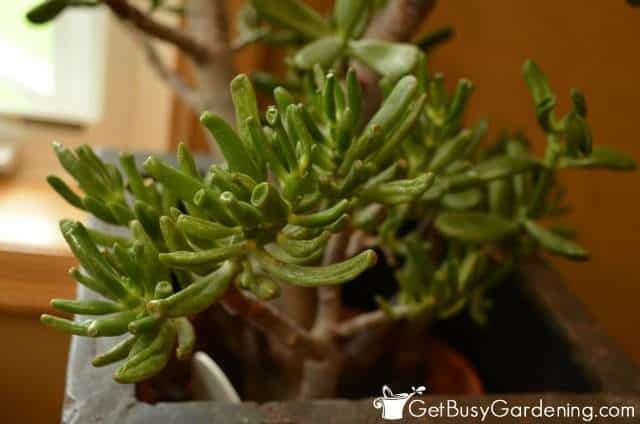
Flowers
Many people are surprised to learn that, with the proper care, jade plants can flower. In warmer climates where they grow outside year-round, they bloom during the winter. But it’s very uncommon indoors without help.
To get your jade plant to bloom, you need to give it similar conditions to what it experiences when it’s outdoors.
The trick is to give it tons of light during the summer. Then, expose it to cooler (but never freezing) temperatures in the fall, and allow the soil to dry out.
When you bring your jade back inside in the fall, put it in a sunny spot, and keep the soil dry. You should start seeing flower buds in a few weeks.
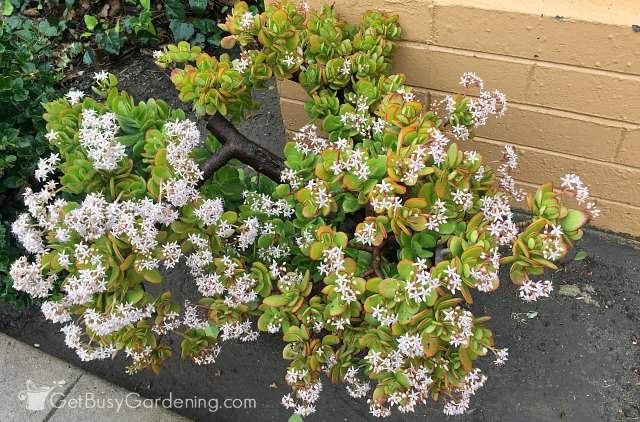
Crassula Toxicity
According to the ASPCA website, jade plants are toxic to dogs and cats if they ingest them.
My cats have never touched mine, but it’s a good idea to keep them out of reach if your pets like to snack on plants, just in case.
Where To Grow Jade Plants
If you live in a warm enough climate, you can grow your jade plant outside year-round. But they also do very well as indoor houseplants.
Hardiness
Jade plants are hardy down to zone 9. They can handle a bit of cold, and are even tolerant of light frost. But they will eventually die if it stays cold for too long.
If you live in an area with harsh winters, then you’ll either need to bring your plant indoors for the winter, or keep it as a houseplant.
Location
The best location to grow your jade plant is a sunny spot with dry soil. Outdoors, plant it in a spot where the ground is very sandy and fast-draining. Indoors grow your potted jade in a sunny, south-facing window.
You could keep it indoors year-round, or put it outside during the summer to give it a growing boost. Just make sure the pot has holes in the bottom, and bring it back inside before it drops below 60°F in the fall.
Related Post: Debugging and Cleaning Potted Plants Before Bringing Them Indoors
Jade Plant Care & Growing Instructions
For the most part, caring for jade plants is easy. But they do have some pretty specific growing requirements. So, for best success, follow my detailed instructions and tips below.
Watering
The biggest mistake that people make with jade plant care is overwatering, and this is their #1 cause of death. Too much will cause root and stem rot, quickly killing your plant.
You can learn exactly how to properly water your jade plant in this guide, but here are a few quick tips:
- Let the soil dry at least 2-3″ deep before giving your plant more.
- When it’s time, water deeply until it starts running out the bottom holes, and let it drain away completely.
- Give your plant less in the winter, and slightly more during the hot summer months.
- If you struggle with getting it right, get yourself an inexpensive soil moisture gauge to make it easy.
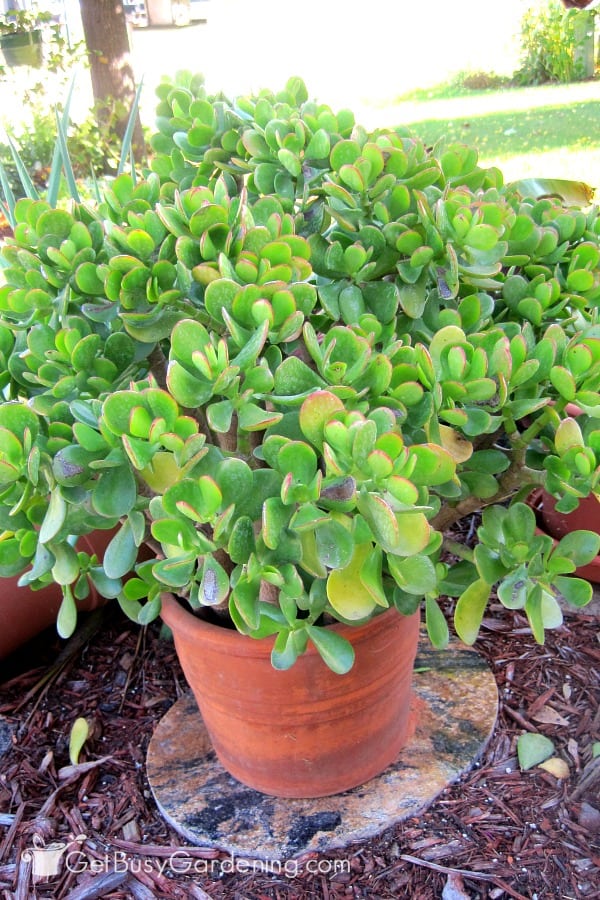
Light Requirements
Though they will tolerate partial shade, jade plants grow best in a full sun location. If it’s too dark, especially indoors, the stems and branches will become weak, thin, and leggy.
With enough sunlight, the stems and leaves will be thick and compact, and the trunk will turn brown and woody at the base. Also, the leaves or tips of your jade plant will turn red, making them even more beautiful.
Here’s are my tips to figure out the ideal amount light for your plant:
- Indoors – Place your plant in a sunny, south-facing window. If you don’t have enough natural sunlight in your house, then add a grow light to supplement.
- Outside – Grow your jade plant in a full sun to partial shade location. If it gets too much shade, then the leaves will stay green and your plant won’t flower.
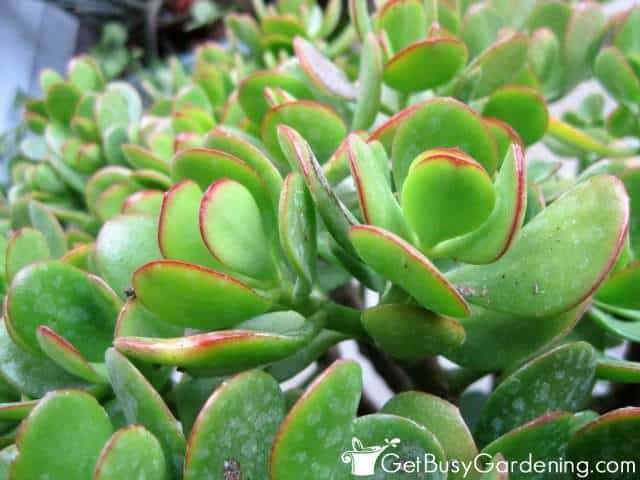
Temperature
Jade plants grow their best when the temps are between 55-85°F. They can handle occasional frost, but they’re not very cold hardy.
They’ll also survive brief periods of freezing temperatures, but will start to suffer if it’s cold for too long. So make sure to protect your plant or bring it indoors if it’s going to stay below 45°F outside.
On the flip side, they can handle the heat in the summer. But the leaves can start to shrivel in extremely hot and dry weather. So you should give your jade a little extra water during extended heatwaves.
Best Soil
Using the correct soil for your jade plant is a crucial part of their care. They need a porous and quick-draining mix. General purpose potting soils hold too much moisture, and can cause your plant to rot.
You can buy succulent soil, get a gritty commercial mix, or you can make your own by mixing coarse sand, potting soil, and perlite.
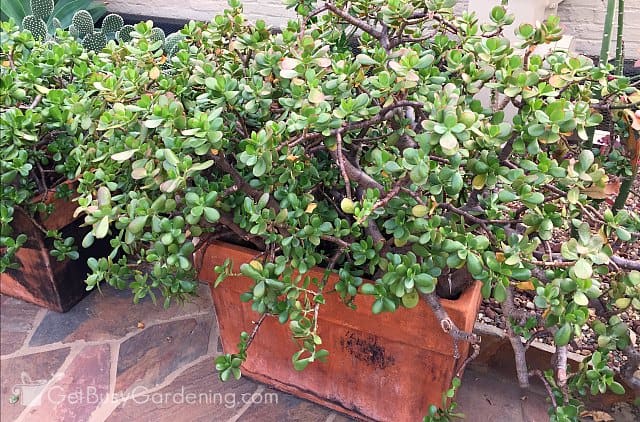
Repotting
Jade plants have very shallow roots, so they can live in the same pot for many years. In fact, it’s better to keep your plant a little root-bound, rather than repotting it too often.
When the time comes, choose a container that is 1-2 sizes larger than the current one. I recommend using an unglazed clay pot, but plastic or another type will work, as long as it has drainage holes in the bottom.
Fertilizer
You don’t need to worry too much about fertilizing as a part of your regular jade plant care routine. But it will help to encourage faster growth and flowers.
Apply a general purpose liquid monthly during spring and summer, or top-dress with slow-release granules once or twice.
Jades go into a dormant state during the colder months, and you should let them rest. So don’t fertilize during the fall and winter, or the new growth will probably be weak and leggy.

Pest Control Tips
Healthy jade plants don’t usually have problems with pests. But sometimes mealybugs, scale, or spider mites can attack them, especially indoors.
You can spot-treat small infestations by soaking a cotton swab in rubbing alcohol and using that to remove the bugs. For a larger or persistent outbreak, treat your plant with neem oil or a insecticidal soap.
Jades can be sensitive to some types of sprays though. So test any product that you want to use on a couple of leaves first to make sure there’s no damage before you treat the whole plant.
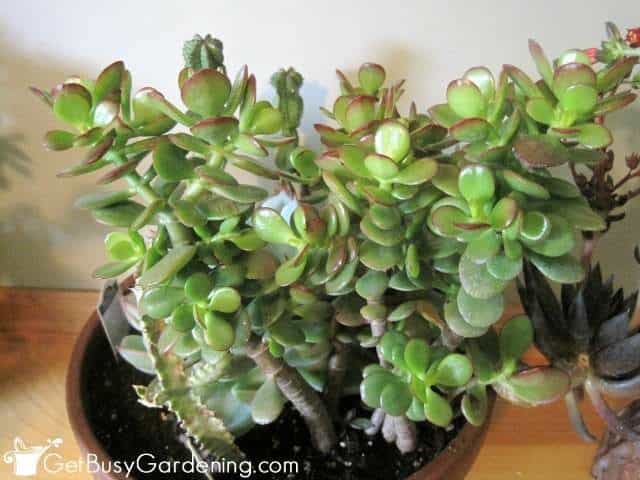
Pruning
Regular pruning is another important part of jade plant care. It will help to keep the foliage compact, and encourages the stems and the trunk to grow thicker.
Pinch off the new tips as they form in the spring or early summer, and use a sharp pair of precision pruners to trim leggy growth and encourage branching.
Get my full step by step instructions for when and how to your prune jade plant here.
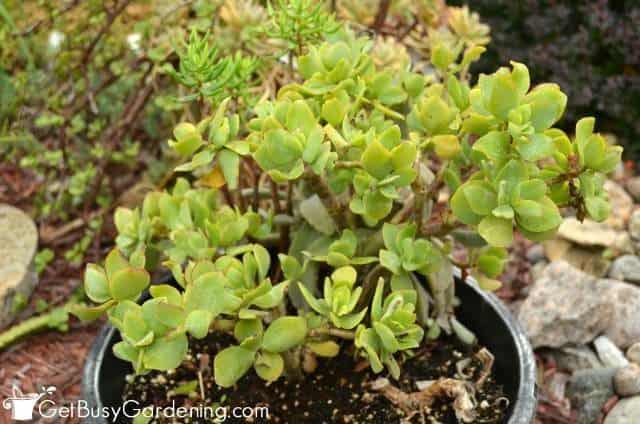
Propagation Tips
Jade plants are extremely easy to propagate, and you can grow tons of new babies by rooting either stem or leaf cuttings.
Allow the cut area to dry for a few days, then dip it in rooting hormone. Plant it in a slightly moist, well-drained soil mix, and in a few weeks it will form roots.
If you want to learn more about how to do it, then check out my detailed step-by-step jade plant propagation instructions here.
Troubleshooting Common Problems
In this section, I’ll help you troubleshoot some of the most common jade plant care problems you may have, with tips for how to fix them.
Leaves Or Branches Falling Off
When the leaves or branches start dropping off, it’s almost always caused by improper watering (usually too much), but it could be from a bug infestation.
Inspect your plant for signs of bugs, and treat any that you find. Ensure the soil dries completely before giving more, but never to the point where the leaves start shriveling or the plant droops. Use a moisture gauge to get it just right.
Mushy Or Rotting Stem Or Leaves
When the stem, branches, or leaves are brown and mushy, then it means they are rotting because of excessive moisture.
If they’re rotting on the top of your jade plant, then you can just prune off the affected parts. Otherwise, if the main stem is mushy, then you’ll have to take healthy cuttings to start new plants.
Leaves Turning Brown
This could be caused by improper watering or sunburn. If the brown leaves are soft and mushy, then they’re rotting from overwatering. Otherwise if they’re dried up and crispy, then your plant isn’t getting enough moisture
Ensure you’re giving your jade the correct amount of moisture, and harden it off before moving it into the full sun to prevent burning.
Trunk & Stems Turning Brown
It’s normal for the main trunk and branches to turn brown and become woody with age, and it means that you’re doing a great job of caring for your jade plant. However, if smaller stems suddenly turn brown after moving them into the direct sun, it is from sunburn.
In that case, move your jade back to the shade, and slowly acclimate it to the full sun over a period of a few weeks.
Shriveling Or Drooping Branches Or Leaves
When the leaves or branches shrivel, that usually means your jade plant isn’t getting enough moisture.
However, it can also be a sign that the stem has rotted. If the base is not mushy, then water your plant more often. Otherwise, treat it for rot.
Roots Growing On The Stem Or Branches
When roots grow on the stem or branches, they are called “aerial roots”. Though it’s not always a problem, this can be triggered by under watering, and also happens when the main stem is rotting.
Ensure your jade is getting enough moisture, and check the entire stem for signs of rot. If all is good, then you can just prune off the stems with aerial roots if they bother you, or leave them be.
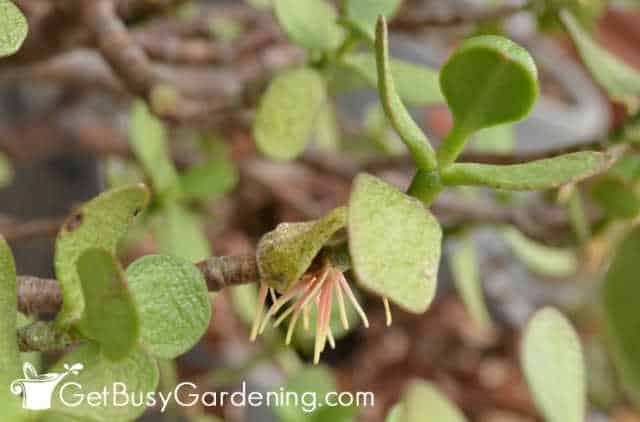
FAQs
Below I will answer some of the most frequently asked questions about growing jades. If you can’t find the answer to your question here, ask it in the comments below.
Is a jade plant indoor or outdoor?
You can grow jade plants either indoors or outdoors, depending on where you live. They aren’t cold hardy though, so you must move them indoors in freezing weather (anywhere less than zone 9).
Do jade plants go dormant?
Though jade plants don’t go fully dormant, they do go into a resting state in the cooler winter months. During this time, growth will slow, and they don’t require as much water.
Does a jade plant like to be root-bound?
Yes, jades like to be root-bound, and can live in the same pot for many years. Their root system isn’t very large, so keeping them in a smaller pot will help prevent overwatering.
Jade plants are easy to care for, and beautiful too. If you follow my detailed tips in this guide, you’ll have no problem keeping yours growing and thriving for decades to come.
If you want to learn all there is to know about maintaining healthy indoor plants, then you need my Houseplant Care eBook. It will show you everything you need to know about how to keep every plant in your home thriving. Download your copy now!
Share your jade plant care tips in the comments section below.


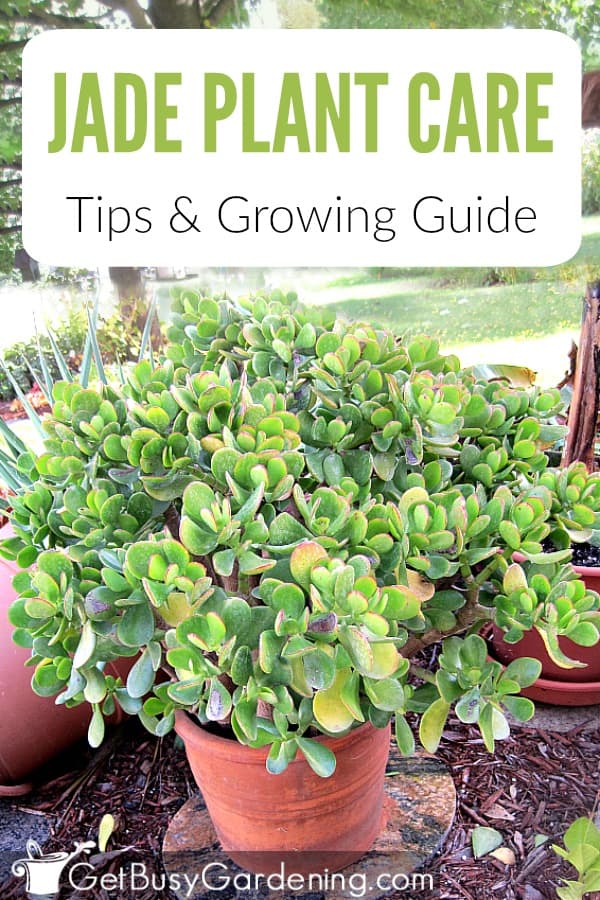
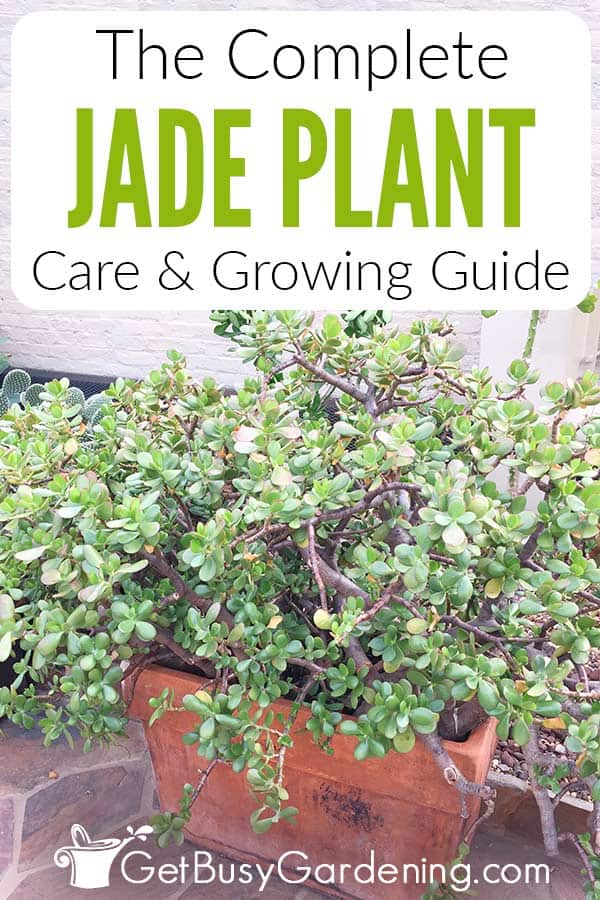
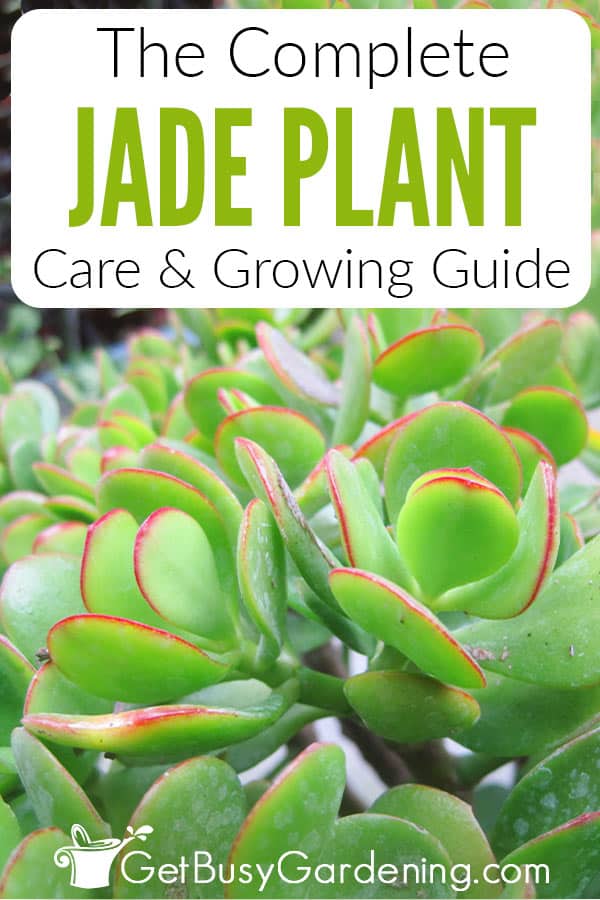
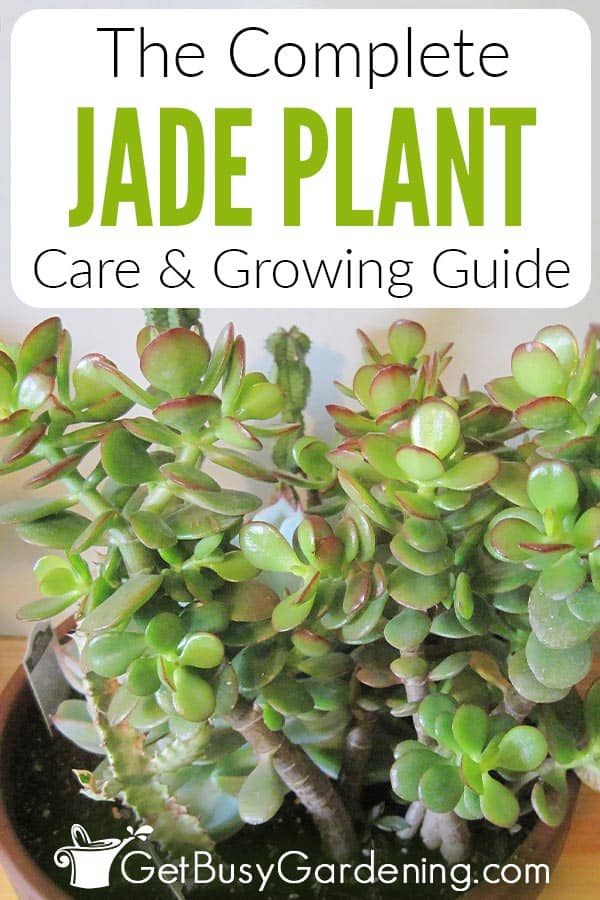
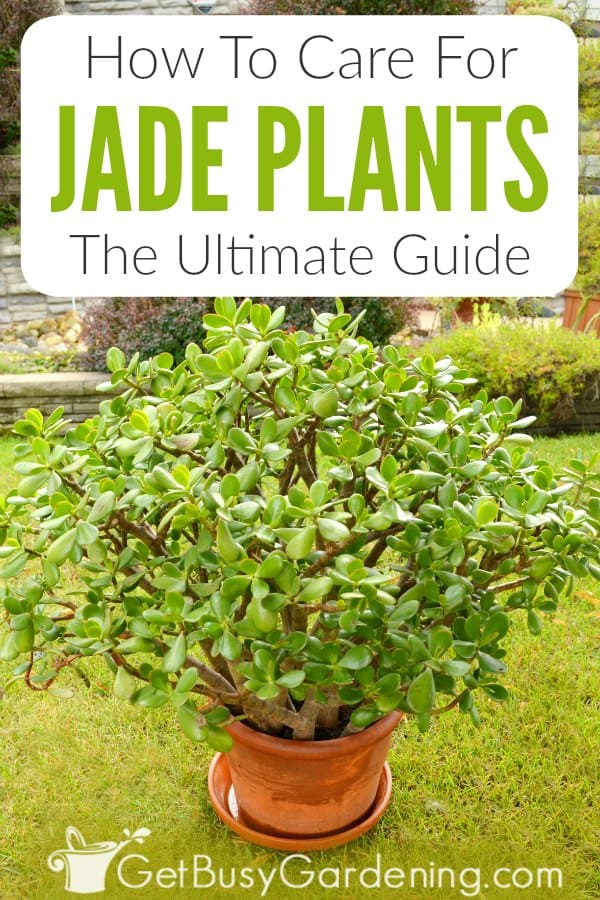
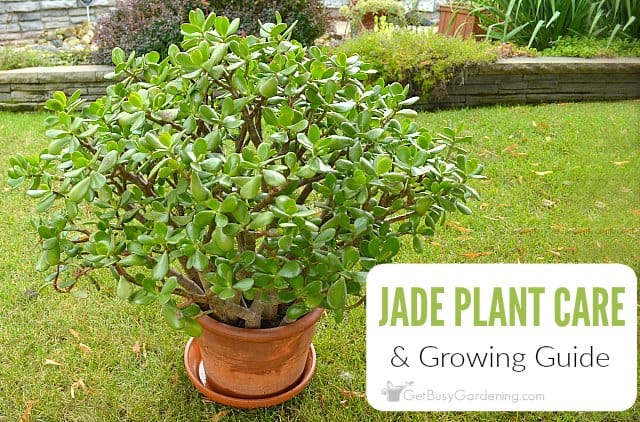




Marilyn Sponzo says
My beautiful Jade plant is falling over! It is outside on our patio and seems healthy. Do I give it a bigger pot? Can I trim it a little? Please help.
Amy Andrychowicz says
If the entire jade plant, pot and all, is falling over because it’s top heavy, then yes, I would move it into a larger container. However, if just the plant is falling over, then check the stem to make sure it’s not rotting.
Madhuri Padamati says
Hi Amy,
I’ve had a curly leaf jade for about 2 months. A branch and a few leaves fell off before I realized that it was not getting enough light. I’ve moved it to a NW facing window a month ago and it’s been doing okay. I see that the leaves aren’t as thick and green like the regular jade plant. Also I see roots coming out of the drainage holes. Is it time to repot? Currently it is in a 4″ dia x4″ H pot. Please suggest what should be my next step.
Thanks in advance!
Amy Andrychowicz says
Yes, if roots are coming out of the drainage holes, then I would repot it. If the leaves are thin, even though you water it properly, that’s another sign that it’s likely pot-bound. Also, jade plants need lots of light. So move it to a south facing window, if you can. Good luck!
Donna says
How do you know when to repot a jade plant? Mine is still pretty small, but I would like an idea when it would be ready. Thank you
Amy Andrychowicz says
Jade plants have fairly shallow roots, and can live in the same pot for many years. Don’t repot it until it has outgrown the container. You’ll be able to tell when you see roots coming out the drainage holes, the pot looks like it’s about to burst, or the plant has gotten too tall and top-heavy for the pot. Here’s detailed post about when and how to repot plants.
Yvette says
Hi Amy – I’m a new jade plant parent but happy to say the had plant I bought 3 yes ago is still alive. However, lately the leaves are quite wrinkled and now developing this whitish scale (like when you get dry skin) on them and some have little white spots. I don’t know if it’s being underwater or a different problem. Any assistance would be so welcome!
Amy Andrychowicz says
Congrats on your success with your jade plant so far! The white scale/spots you mention could be a type of bug infestation. Here are a few articles that may help you make a positive ID…
How To Get Rid Of Scale Insects On Houseplants
How To Get Rid Of Mealybugs On Your Houseplants
When you say it’s wrinkly, that does make me wonder if it’s not getting enough water. But, check the stem and base of your jade first to make sure it’s not mushy. Because wrinkly leaves could be a symptom of stem rot from overwatering too. Good luck!
Leena says
I live in the Pacific Northwest (Zone 8b) and am very new to plants. I recently purchased a two feet grown Jade tree. However, I’ve experienced several problems since the very first day including: whole branches softening and falling off, black raised spots on yellow/light green leaves, dark scabs embedded on the side of the leaves, and tiny white specks on top of the leaves. It had sparse and small leaves with very flexible branches. I thought it was overwatered so I waited for the soil to dry out completely. After 3 weeks, I finally watered it and then used organic liquid fertilizer which has helped it pop up new greener leaves and mildly improved the stiffness of the branches. I’ve also been using rubbing alcohol and a q-tip to clean the leaves with the black spots and some slowly fell off but left scars. On the fourth week, I brought the tree back into the nursery I purchased it from to see what was going on. However, I was told it was fine and could have been the adjustment period. They suggested repotting it which was part of their service.
They ended up recommending me a Lechuza self-watering pot which I’m starting to question if that was a sound purchase? Should I switch to a different planter pot? The self-watering pot seems to go against what this plant needs after much research. Also, are their ways to improve my Jade’s condition?
Amy Andrychowicz says
Sorry to hear that your jade plant is struggling so much! It sounds to me like it is/was being overwatered, as you mentioned. The soft branches that are falling off, and black spots on the leaves could both be due to overwatering, as well as the yellow leaves. The soil should dry out completely before watering again, every single time. I would hold off on fertilizing it again until it has recovered. Fertilizing an already sick plant could send it over the edge, and end up killing it.
I would also check the leaves for scale (hard scabs that leave a scar when removed), and possibly mealybugs (tiny white specks on the leaves).
As for the self-watering pot… I’m afraid your garden center gave you some bad advice, which is a shame. You definitely don’t want to grow jades in a self-watering pot, or they will likely end up rotting over time. The best container to use for growing jade plants (especially since it sounds like you’re overwatering) would be an unglazed terracotta pot. That will wick moisture away from the soil, and allow it to out dry faster. Good luck!
Nadine says
I have a jade that I’ve been growing over the past 15 years, every summer it goes outside. I never knew it could bloom either until a couple of years ago where, like you, it was by accident that I discovered it! That year I had left it out until the first frost was forecasted. The following year, I brought it in too early and it didn’t bloom. Last year I left it out as long as possible and again got the blooms.
Amy Andrychowicz says
Awesome that your jade bloomed for you! That is so cool. Sounds like you’ve figured out the trick for getting them to flower. The cooler temps is key.
Bren da says
My jade plant got a major sunburn! Now what?
Amy Andrychowicz says
Oh no, I’m so sorry to hear your jade got sunburn! What a bummer! The first thing to do is move it out of the sun right away. Keep it in a shady spot for a few days, and let it recover. Check on it daily to see how the it’s doing. Don’t prune off any of the damaged leaves, just leave it alone. If any of the damaged branches or leaves turn mushy, then prune them off. Otherwise, you can leave the damaged leaves on the plant, and they will eventually drop off on their own as your jade recovers. It may look bad for a few months, but it should recover just fine.
It’s important to slowly acclimate jades to living in full sun. So, after letting it sit in the shade for a week or so, slowly start moving it to the sun. I usually give it a few hours of morning sun for a few days, then move it a little further into the sun, and give it a few more days before moving it again. It takes a few weeks for them to acclimate. Good luck!
Samantha says
Hello! A cat decided to play with my jade and knocked it over. It now doesn’t have roots. What’s the best way to recover it? Will the roots grow back?
Amy Andrychowicz says
Oh no! Sorry to hear that your cat knocked over your jade plant. Darn it! The good news is that they are really easy to propagate, and it doesn’t take long to grow roots again. Here are step-by-step instructions for how to root your jade plant. Good luck!
Zalina Rahaman says
Hi Amy
I do an almost daily inspection of one of my Jade plants for Mealy bug and saw a few brown spots on the underside of the leaves. What could this be and what does it mean?
Looking forward to your response. This plant is taking a beating since I bought it. Seems it came with the bug.
Zalina
Amy Andrychowicz says
Oh bummer, sorry to hear your jade has bugs! It sounds like houseplant scale to me, and here’s how to get rid of it… How To Get Rid Of Scale Insects On Houseplants.
Barbara jordan says
I Have a jade plant that has roots growing all along the stem top to bottom. it needs to be cut back but I was wondering if I should cut those little red stop or just leave them be?
Amy Andrychowicz says
I think you’re asking if you should cut off the roots that are growing along the stems of your jade plant? If so, there is no need to do that. You certainly could if you don’t like how they look, but they don’t hurt the plant.
Kathleen says
Which jade plant food do you suggest. I checked on line and many of the reviews are conflicting. Help
Amy Andrychowicz says
Search in the post above for the section titled “Jade Plant Fertilizer”. I have a bunch of suggested products that I use and love listed in that section.
Kathleen Meitz says
my water is softened. Can I use this on my new Jade plant or do I need to buy distilled water
Amy Andrychowicz says
I recommend using either rainwater or distilled water on jade plants. The salt from your water softener can build up in the soil over time. If tap water is your only option, then let it sit out for 24 hours so the chlorine can evaporate. You may also be able to find a water filter that will remove the salts and chemicals from your tap water.
Kathleen Meitz says
Thanks for your help. Is it normal for some of the leaves to turn yellow and fall off?
Amy Andrychowicz says
You’re welcome. No, it’s not normal for jade plant leaves to turn yellow and fall off. That is usually a sign that it’s being overwatered. Make sure you’re letting the soil dry out completely before watering again.
Linda says
I have left my Jade plant when it frosted overnight. The leaves are all droopy and possible dead. Will it survive if I trim off the dead leaves { most of them}? I believe the roots were not damaged. Will it, can it come back from the roots?
Amy Andrychowicz says
Oh no, sorry to hear your jade plant was damaged by frost. If the frost-damaged leaves are mushy then yes, definitely prune those off. Otherwise, if they are just drooping, they may recover. In that case, I would just leave it alone and give it more time to see if it pops back. Time will tell. And yes, jades can handle pretty hard pruning, so no worries there (although you don’t want to cut off all the leaves). It won’t come back from the roots, but new branches and leaves will grow on the stems below the cuts.
Naomi says
I visited LosAngeles in December and went back home to Ohio with 3 starts from a Jade tree that was outside in my friends yard. When I got home I put the clippings on my porch and forgot about it until May. When I took it out of the bag it was still very much alive. I potted it and it eventually grew to about 3 feet tall. Amazing. I still don’t believe it.
Amy Andrychowicz says
OMG, that is so funny!! Glad to hear that your jade cuttings survived all winter out on your porch, and still grew to be a nice sized plant. That’s nuts!
Tal Saarony says
Hello Amy,
Thanks so much for your post and all the advice!
I received a rooted cutting from a friend. It is very healthy and has been growing well; however, it has just the one stem that keeps getting taller, about 6″ by now. Should I just pinch the top 2 leaves? I would love as much branching from that one column as possible…
It is fall now, can I still do it?
Should I wait for new baby leaves, or can I pinch the current top ones which are not tiny?
Anything else I can do to encourage branching?
Thanks so much
Amy Andrychowicz says
Yes, regular pinching and pruning will encourage your jade plant to branch out and grow bushier. I recommend waiting until spring to prune or pinch it though.
Caroline says
I’m so glad I came across your website! I just happened to get my hands on a baby jade tree last year and I’ve been winging it in regards to her care. She’s been doing really well despite the fact that there’s been a lot of trial and error, but now I’m looking forward to see her bloom!
Amy Andrychowicz says
Awesome! Congrats on your new baby jade plant. Have fun, and I hope she grows well for you!
Shirley Darby says
Amy, I have a jade “tree,” about 24″ tall by 20″ wide, and a trunk at least 2″ in diameter. It is growing straight, and has always done very well, inside or out, although it has gotten too heavy (in a ceramic pot) to move far. In the last two months (July/August) it has had a rash of branches breaking off, from various parts. These are the smaller ones (1/4″ diameter) growing from the main side branches. They just suddenly break off, for no reason! No bugs, no disease, no pets, no wind. It never had any breakage when it was outdoors in windy weather, and our winds can get pretty strong in Kansas! It has not been outdoors for 2 years now, and has been in south windows. Otherwise, it seems to be healthy. It is self-pruning? Just to look at it, you wouldn’t know it has lost branches. thank you for sharing your knowledge.
Amy Andrychowicz says
When jade plants drop their leaves or branches, it’s usually due to improper watering. Most of the time it’s caused by overwatering, but in rare cases it could be underwatering. I know it’s been a very rainy summer for many, so if your jade has been outside all summer, then it may have been getting too much moisture. When it’s outdoors, make sure the plant is in full sun, is potted in a very fast draining, porous soil, and the pot has plenty of drainage holes. You want the soil to dry out very quickly after it rains. Also, unless you have a drought or it’s extremely dry where you live, you won’t need to water the plant all summer.
Shirley Darby says
In this case, it’s more likely to be underwatering, as I pass it by more often than not when watering the other houseplants, which isn’t even once a week. I have watered it more often, and I put it in a sunnier window, and no branches have dropped since. Thank you.
Amy Andrychowicz says
Awesome, glad you were able to stop your jade from dropping more branches! You’re welcome! 🙂